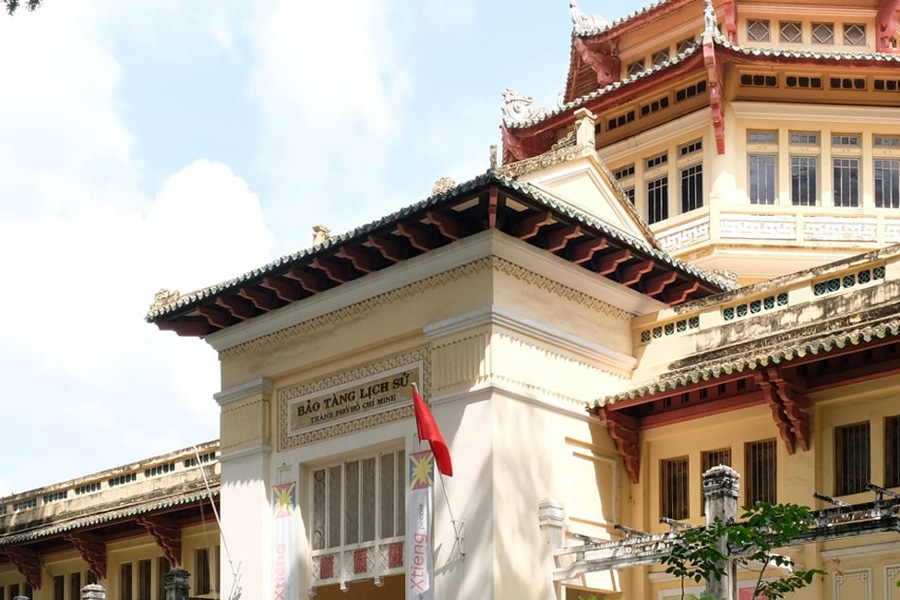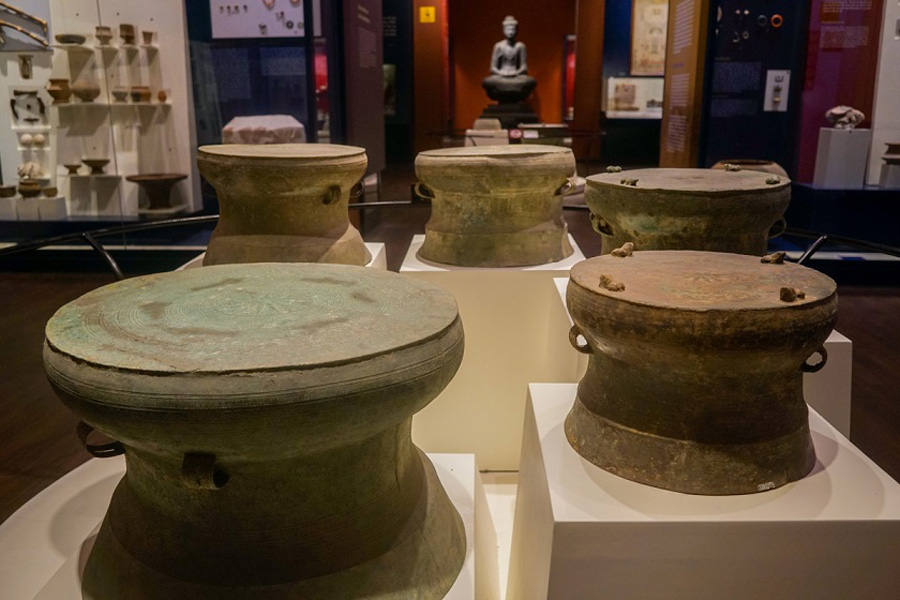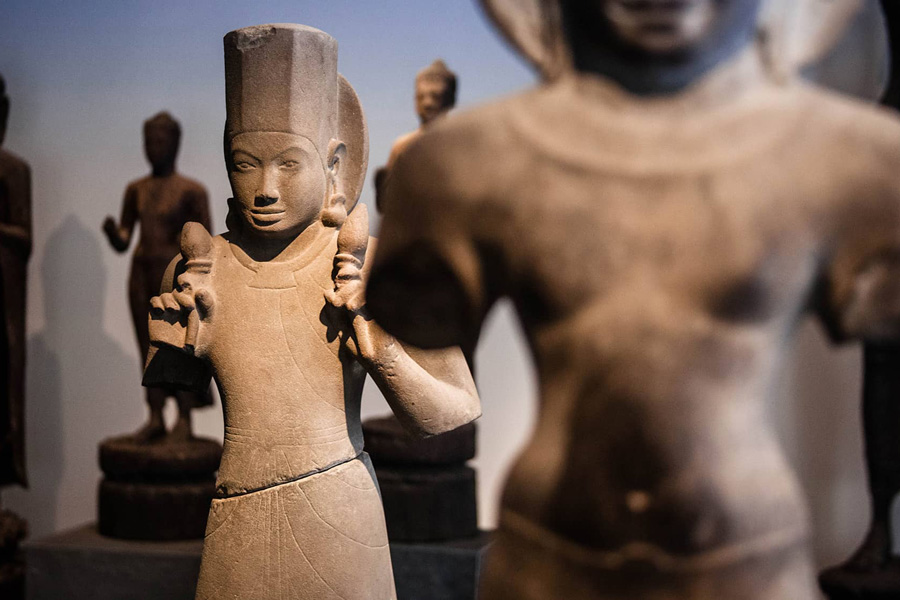Vietnam History Museum

The Vietnam History Museum of Ho Chi Minh City, situated at No. 2 Nguyen Binh Khiem Street in District 1, stands as a historical repository that chronicles the captivating narrative of Ho Chi Minh City and its surrounding regions. Established in 1975, the museum meticulously captures the essence of Vietnam's past, offering a journey through time that spans prehistoric epochs to more recent events. Its thematic exhibits present a rich tapestry of history, encompassing the eras of the Funan and Champa Kingdoms, periods of Chinese and Khmer influence, and significant chapters like the French and American wars.
(1).jpg) Ho Chi Minh City History Museum with unique architecture
Ho Chi Minh City History Museum with unique architecture
Through an impressive array of artifacts, photographs, and documents, the museum provides visitors with a comprehensive understanding of the cultural and historical evolution of this dynamic region. Renovations and ongoing efforts to maintain the museum's integrity ensure that it remains a vital hub for those eager to explore the profound history of Ho Chi Minh City.
The History Museum of Ho Chi Minh City occupies an architectural gem that likely traces its origins to the French colonial era, an era marked by the construction of buildings that would later become cultural landmarks. The specific genesis of the museum may be somewhat elusive, but its establishment aligns with the post-independence period following the conclusion of the Vietnam War in 1975, a pivotal moment when North and South Vietnam were reunified. This transformative period witnessed the reevaluation and repurposing of cultural institutions to reflect the unified nation's narrative. The museum's mandate, therefore, extends beyond the confines of a mere physical structure; it embodies a commitment to curating and preserving the rich historical tapestry of Ho Chi Minh City and its integral role in Vietnam's broader history.
 History museum of Ho Chi Minh City-A heritage preserver
History museum of Ho Chi Minh City-A heritage preserver
As visitors traverse the museum's halls, they embark on a captivating journey through time, encountering exhibits and collections that meticulously chronicle the region's cultural evolution. From artifacts representing ancient civilizations to poignant displays highlighting the struggles for independence, each section contributes to an immersive narrative that transcends epochs. The museum serves as more than a repository of historical artifacts; it is a dynamic educational space, fostering an understanding of the diverse cultural influences, pivotal events, and societal developments that have shaped Ho Chi Minh City.
Furthermore, the museum's location within a colonial-era structure adds an extra layer of historical significance. The architecture itself stands as a tangible link to Vietnam's complex past, a visual representation of the intersections between colonial legacies and the nation's quest for self-determination.
In essence, the History Museum of Ho Chi Minh City is not merely a testament to the city's past but an embodiment of Vietnam's enduring spirit and resilience. Its existence underscores a commitment to cultural preservation and education, inviting visitors to delve into the layers of history that have defined this vibrant and dynamic region within the broader context of Vietnam's narrative.
Weather in Vietnam History Museum in Sai Gon (Ho Chi Minh City) is generally during the dry season, which typically runs from November to April. During these months, the weather is more predictable, with lower humidity and minimal rainfall, making it more comfortable for outdoor activities and museum exploration.
Specifically, the months of December to February are often considered the peak tourist season in Vietnam, including Ho Chi Minh City, as the weather is cooler and more pleasant. However, keep in mind that this period may also coincide with higher numbers of tourists.
If you prefer to avoid crowds and still enjoy favorable weather, the shoulder months of November and March-April can be good options. During these months, the weather is generally pleasant, and tourist numbers are lower than during the peak season.
See more: Paradise for Honeymooners
Dong Son Culture Exhibit:
 Dong Son cultural exhibition inside Vietnam History Museum
Dong Son cultural exhibition inside Vietnam History Museum
The museum boasts an impressive collection of artifacts from the Dong Son culture, which flourished in Vietnam during the Bronze Age (circa 1000 BCE to 1 CE).
Dong Son artifacts are renowned for their intricate bronze drums, tools, weapons, and other items, showcasing advanced craftsmanship and providing insights into the cultural and technological advancements of the time.
Historical Evolution Exhibits:
The museum offers a chronological journey through Vietnam's history, from prehistoric times to the modern era. This allows visitors to grasp the continuity and evolution of Vietnamese culture and civilization.
Exhibits cover various historical periods, including the Funan and Champa Kingdoms, the periods of Chinese and Khmer influence, the feudal dynasties, and more recent events such as the French and American wars.
Cultural Diversity:
 Stone statues are displayed inside Vietnam History Museum
Stone statues are displayed inside Vietnam History Museum
The museum highlights the cultural diversity of Vietnam, emphasizing the influences of different civilizations and dynasties on the country's art, architecture, and way of life.
Visitors can explore exhibits that showcase the unique characteristics of various regions and ethnic groups within Vietnam.
Educational Value:
The museum provides a comprehensive educational experience, with well-curated displays, informative captions, and multimedia presentations that enhance the understanding of Vietnam's history.
It serves as an excellent resource for both locals and international visitors seeking a deeper insight into the nation's cultural heritage.
French Colonial Architecture:
The museum is housed in a historic French colonial building, adding an extra layer of charm and significance to the visitor experience. The architectural setting itself is a testament to the intersection of Vietnamese history and French colonial influence.
Navigating the vibrant streets of Ho Chi Minh City to reach the Vietnam History Museum is a captivating adventure in itself. Whether you choose the convenience of a taxi or ride-hailing service, the agility of a motorbike taxi, or the charm of a cyclo, each mode of transportation adds its own flair to the journey.
The museum, nestled in the heart of District 1, is also accessible by public buses, providing a more local experience for those inclined to explore the city's public transit. As you approach the museum's location at 2 Nguyen Binh Khiem Street, the French colonial architecture that houses the institution becomes increasingly apparent, setting the stage for an immersive exploration of Vietnam's rich and diverse history. The journey to the Vietnam History Museum is not just a means of transportation; it's an integral part of the cultural odyssey that awaits within its walls.
See more: Sapa biking to Dien Bien Phu 4 days